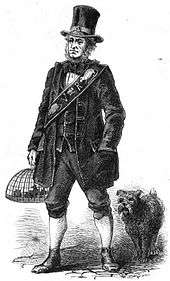Jack Black (rat catcher)

Jack Black was a rat-catcher and mole destroyer from Battersea, England during the middle of the nineteenth century.[1][2] Black cut a striking figure in his self-made "uniform" of scarlet topcoat, waistcoat, and breeches, with a huge leather sash inset with cast-iron rats. Black promoted himself as the Queen's official rat-catcher, but he never held a royal warrant.[2]
He is known particularly through Henry Mayhew's account in London Labour and the London Poor, where he tells Mayhew of his work and experiences, including a number of occasions when he nearly died from infection following rat bites.[1]

When he caught any unusually coloured rats, he bred them, to establish new colour varieties. He would sell his home-bred domesticated coloured rats as pets, mainly, as Black observed, "to well-bred young ladies to keep in squirrel cages". Beatrix Potter is believed to have been one of his customers, and she dedicated the book Samuel Whiskers to her rat of the same name.[2] The more sophisticated ladies of court kept their rats in dainty gilded cages, and even Queen Victoria herself kept a rat or two. It was in this way that domesticated—or fancy—rats were established. Black also supplied live rats for rat-baiting in pits, a popular mid-Victorian pastime.[2]
Black had a number of sidelines beyond rats, including fishing (for food and supplying aquaria), bird catching and taxidermy.[1] He was also an accomplished dog breeder. He told Mayhew: "I had a little rat dog—a black tan terrier of the name of Billy—which was the greatest stock dog in London of that day. He is the father of the greatest portion of the small black tan dogs in London now [...]. [...] I've been offered a sovereign a-pound for some of my little terriers, but it wouldn't pay me at that price, for they weren't heavier than two or three pounds. I once sold one of the dogs, of this same strain, for fourteen pounds, to the Austrian Ambassador. [...]; in fact, my terrier dog was known to all the London fancy. As rat-killing dogs, there's no equal to that strain of black tan terriers."[1]
See also
| Wikisource has original text related to this article: |
- Rat-baiting
- Jemmy Shaw
- Your Friend the Rat, a Pixar short film which briefly mentions Black in the history of rats.
References
- 1 2 3 4 5 Mayhew, Henry (1851). "Chapter I: The Destroyers of Vermin". London Labour and the London Poor, Volume 3.
- 1 2 3 4 McCullough, Marie (May 10, 2015). "Sniffing out the dirty history of the common rat". Philadelphia Inquirer. p. B2.
External links
- American Fancy Rat & Mouse Association – History of rat fancy